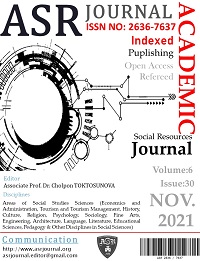Author :
Abstract
Kurumsal Sosyal Sorumluluk (KSS) en genel tanımıyla toplumun yararı kapsamında gerçekleştirilen kurum/işletme faaliyetleri ve uygulamalarıdır. KSS’nin kurumların davranışlarını geçmişten günümüze ne yönde/nasıl etkilediği konusu bir süreci işaret etmektedir. Bu kapsamda çalışmanın amacı KSS literatürünü kronolojik bir yaklaşımla inceleyerek kavramın gelişim sürecini ve evrimini ortaya koymaktır. Bu kapsamda çalışmanın bulgularına bakılacak olursa 1950’li yıllarda işletmelerin KSS’yi ticari faydalarla ilişkilendirmediği görülmektedir. Bu yıllardaki KSS anlamı salt bir şekilde topluma karşı olan sorumluluklar şeklindedir. 1960 ve 1970’lerda ise KSS’nin kurumsal finansal performans ile ilişkilendirilebileceğine dair ufak kıvılcımların olduğunu söylemek mümkündür. 1980’lere bakıldığında ticari ve sosyal çıkarların daha belirgin bir şekilde yakınlaştığını ve firmaların paydaşlarına karşı daha duyarlı hale geldiklerini söylemek mümkündür. Ayrıca bu yakınlaşma konuyla ilgili çalışmalar yapan araştırmacıların yeni KSS tanımları geliştirmesine de katkı sağlamıştır. 1990’lara gelindiğinde ise KSS fikrinin küresel bir anlayışla ve neredeyse tüm kurumsal kesimlerce onaylandığı ve kabul gördüğü görülmektedir. Ve nihayet 2000’li yıllarda KSS stratejik yönetim literatürü ile de bütünleşerek kurumsal, sosyal ve çevresel sürdürülebilirliği sağlamanın başat unsurları arasında yerini alarak stratejik bir boyut kazanmıştır.
Keywords
Abstract
In its most general definition, Corporate Social Responsibility (CSR) is corporate activities and practices carried out within the scope of the benefit of society. The issue of how CSR affects the behavior of institutions from past to present points to a process. In this context, the aim of the study is to examine the CSR literature with a chronological approach and to reveal the development process and evolution of the concept. In this context, if we look at the findings of the study, it is seen that businesses did not associate CSR with commercial benefits in the 1950s. The meaning of CSR in these years is purely responsibilities towards society. In the 1960s and 1970s, it is possible to say that there were small sparks that CSR could be associated with corporate financial performance. Looking at the 1980s, it is possible to say that commercial and social interests converged more clearly and companies became more sensitive to their stakeholders. In addition, this convergence has also contributed to the development of new definitions of CSR by researchers working on the subject. By the 1990s, it is seen that the idea of CSR was approved with a global understanding and by almost all corporate segments. And finally, in the 2000s, CSR gained a strategic dimension by integrating with the strategic management literature, taking its place among the main elements of ensuring corporate, social and environmental sustainability.
Keywords
- Bowen, H. (1953), Social Responsibilities of the Businessman, Harper, New York, NY.
- Bowen, H. (1953), Social Responsibilities of the Businessman, Harper, New York, NY.
- Carroll, A.B. (1979), ‘‘A Three-Dimensional Conceptual Model of Corporate Performance’’, Academy of Management Review, Vol. 4, pp. 497-505.
- Carroll, A. B. (1999). Corporate Social Responsibility: Evolution of A Definitional Construct. Business & Society, 38(3), 268-295.
- Carroll, A.B. (2008), ‘‘A History of Corporate Social Responsibility: Concepts and Practices’’, in Crane, A.,McWilliams, A., Matten, M., Moon, J. and Siegel, D. (Eds), The Oxford Handbook of Corporate Social Responsibility, Oxford University Press, Oxford, pp. 19-46.
- Carroll, A.B. and Shabana, K.M. (2010), ‘‘The Business Case for Corporate Social Responsibility: A Reviewof Concepts, Research and Practice’’, International Journal of Management Reviews, Vol. 12 No. 1, pp. 85-Cochran, P.L. and Wood, R.A. (1984), ‘‘Corporate Social Responsibility and Financial Performance’’, Academy of Management Journal, Vol. 27, pp. 42-56.
- Davis, K. (1967), ‘‘Understanding the Social Responsibility Puzzle: What Does the Businessman Owe to Society?’’, Business Horizons, Vol. 10 No. 4, pp. 45-50.
- Davis, K. (1973), ‘‘The Case for and Against Business Assumption of Social Responsibilities’’, Academy of Management Journal, Vol. 16, pp. 312-22
- Donaldson, T. (1982), Corporations and Morality, Prentice Hall, Englewood Cliffs, NJ.
- Donaldson, T. and Preston, L.E. (1995), ‘‘The Stakeholder Theory of the Corporation: Concepts, Evidence, and Implications’’, Academy of Management Review, Vol. 20, pp. 65-91.
- Drucker, P.F. (1954), The Practice of Management, Collins, New York, NY, (reprinted 2006).
- Drucker, P.F. (1984), ‘‘The New Meaning of Corporate Social Responsibility’’, California Management Review, Vol. 26, pp. 53-63.
- Frederick, W.C. (1960), ‘‘The Growing Concern over Business Responsibility’’, California Management Review, Vol. 2 No. 4, pp. 52-61.
- Frederick, W.C. (2006), Corporation, Be Good! The Story of Corporate Social Responsibility, Dogear Publishing, Indianapolis, IN.
- Freeman, R.E. (1984), Strategic Management: A Stakeholder Approach, Pitman, Boston, MA.
- Jones, T. M. (1980). Corporate Social Responsibility Revisited, Redefined. California management review, 22(3), 59-67.
- Lee, M.P. (2008), ‘‘A Review of the Theories of Corporate Social Responsibility: Its Evolutionary Path and the Road ahead’’, International Journal of Management Reviews, Vol. 10, pp. 53-73.
- McGuire, J. W., & McGuire, J. W. (1963). Business and society (Vol. 45097). McGraw-hill.
- Moura‐Leite, R. C., & Padgett, R. C. (2011). Historical Background of Corporate Social Responsibility. Social Responsibility Journal. Vol. 7 Issue: 4, pp.528-539.
- Preston, L.E. and Post, J.E. (1981), ‘‘Private Management and Public Policy’’, California Management Review, Vol. 23 No. 3, pp. 56-62.
- Vogel, D.J. (2005), ‘‘Is There A Market for Virtue? The Business Case for Corporate Social Responsibility’’, California Management Review, Vol. 47, pp. 19-45.
- Waddock, S. (2004), ‘‘Parallel Universes: Companies, Academics, and the Progress of Corporate Citizenship’’, Business and Society Review, Vol. 109, pp. 5-42.
- Waddock, S. (2008), ‘‘Building A New Institutional Infrastructure for Corporate Responsibility’’, Academy of Management Perspectives, pp. 87-108.
- Walton, C. C. (1967). Corporate Social Responsibilities. Wadsworth Publishing Company.
- Wood, D.J. (1991), ‘‘Corporate Social Performance Revisited’’, Academy of Management Review, Vol. 16, pp. 691-718.
- Wood, D.J. (2010), ‘‘Measuring Corporate Social Performance: A Review’’, International Journal of Management Reviews, Vol. 12, pp. 51-84.
